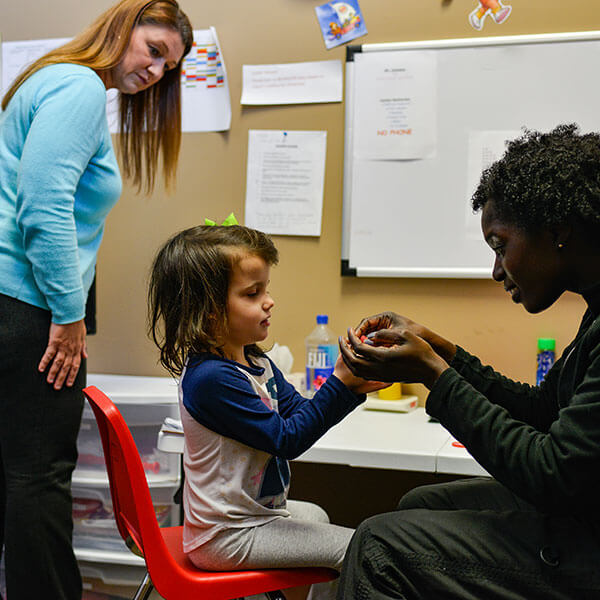What to Expect from Autism Testing: The Process for an Autism Diagnosis for Children
June 13, 2023
June 13, 2023

For families of individuals who are suspected of having an autism spectrum disorder (ASD), the autism testing process may seem mysterious – and maybe even intimidating for some – but it doesn’t have to be that way! At Hopebridge, we have a focused approach around early identification and our team is here to make it as seamless as possible for you.
To shed light on the assessment process from start to finish, we talked to our diagnostic team to outline what an autism evaluation looks like from a caregiver’s perspective:
The initial step of the evaluation process is the referral. Referrals come to Hopebridge by phone, fax or the contact form on the ‘Get Started‘ page of our website or Facebook questionnaire. Likewise, a referral may come directly from a primary caregiver or physician who suspects a child may be on the spectrum. Referrals are facilitated by our patient intake department.
During the intake portion of the process, one of Hopebridge’s client advocates will record patient and guardian information, primary care physician and any other medical information necessary to continue. They also obtain and verify the child’s insurance benefits. Once completed, the client advocate calls the family to ensure they understand the benefits that will be covered. At this time, they walk them through the basics of the test for autism and provides information on applied behavior analysis (ABA therapy), speech therapy and occupational therapy. When the family confirms their desire to continue the evaluation process, the client advocate works to obtain a prior authorization for the appointment.
As soon as the pre-authorization for the evaluation is obtained from the insurance company, the appointments are scheduled based on availability of the primary caregiver (a parent or legal guardian must be present) and the clinician who will complete the evaluation.
The testing process at Hopebridge will occur over one or two appointments, depending on a few different factors. Appointments can be accommodated within as early as two weeks, in some cases. Even at the later end, around 90 days, wait times are still often up to six months earlier than other local options.
Once the testing appointments are scheduled, the child’s caregiver will receive a link to HB Portal, Hopebridge’s all-in-one platform for families to provide and access patient information. Families must complete important paperwork – which includes questions regarding the child’s developmental milestones, behaviors and medical history – prior to any assessments and appointments. Theses completed documents are crucial to the evaluation and will be taken into consideration alongside other measures.
The first step is a caregiver interview with the diagnostician, which is held virtually for the family’s convenience and allows us to be more efficient in our time with them. The diagnostician collects the child’s social-developmental history and any current concerns around behaviors and skills. It is important that a parent or primary caregiver is involved in this appointment to ensure the most accurate information is presented during the interview. This portion of the process takes approximately one hour, but may vary based on the child and information presented.
Clinical observations and cognitive testing may be administered within the same appointment for those receiving telehealth evaluations, or could continue in a separate, second appointment for in-person testing.
If in person, families should arrive 30 minutes prior to the appointment. The appointment is expected to last up to two hours. Virtual appointments are typically shorter since external factors, such as new spaces and new faces, are reduced.
During the appointment, the diagnostician may use a combination of standardized measures to determine if the criteria for an autism diagnosis, as defined by the DSM-5, is met. The assessments may vary slightly from child to child, depending on a few different factors related to the individual being evaluated, such as speech level and age, as well as whether the appointment is held face-to-face or virtually.
For example, one tool that can be used during in-person appointments is the Autism Diagnostic Observation Scale, Second Edition (ADOS-2) which assesses communication, social interaction and play through four modules.
For a younger child who does not speak verbally, the evaluation involves a number of activities designed to bring out behaviors and social characteristics associated with autism spectrum disorder. To families, this part of the test for autism might sometimes appear as though their child was simply playing, however, the clinician is facilitating specific scenarios and activities to closely observe the child’s behaviors, social skills and sensory responses.
In the case of a child who is fully verbal, the assessment involves more than a dozen activities, all of which are designed to bring out speech, language patterns, behavior and social characteristics found in an individual with autism spectrum disorder. To parents, this would appear as though the evaluator was observing and interacting with the child while he or she is engaged in different types of activities, including play and problem-solving.
Following the test administration, the diagnostician will score the assessments. The clinician will then provide feedback and educate the family as to whether the child meets the criteria for autism, as well as any recommendations for treatment.
The diagnostic team also alerts Hopebridge’s patient intake team to the results and whether there is a diagnosis. Results are uploaded directly to the patient portal for the caregiver to access and will also be sent to the child’s pediatrician or referring physician.
It’s important to note that Hopebridge’s diagnostic evaluation appointments are specifically focused on autism in order to improve access to early identification and early intervention for as many children and families as possible. If the clinician feels there are other factors beyond autism that could be affecting the child, they can refer or recommend the caregiver seek additional testing or support.

Hopebridge makes an autism assessment process as simple and seamless as possible for you and your child.
Once the client advocate receives the completed diagnostic report and recommendations, they will review any recommendations for ongoing therapy, such as ABA, speech and occupational therapy, which are often the next steps to getting life-changing care. As with autism testing, once prior verification is obtained from the insurance company, the client advocate will then contact the family to schedule the additional recommended services with a Board Certified Behavior Analyst (BCBA), occupational therapist and/or speech-language pathologist.
With this brief outline, we hope this clears up some questions (and answers!) for you. At Hopebridge, our mission is to help children with autism lead their best lives, and many times, that begins with the autism evaluation. Get scheduled today by filling out the easy form on our website and we can set up your child for autism testing soon.
Autism Therapy
April 01, 2023
1 in 36 Children Have Autism: What the Increased Prevalence Means for Your Family